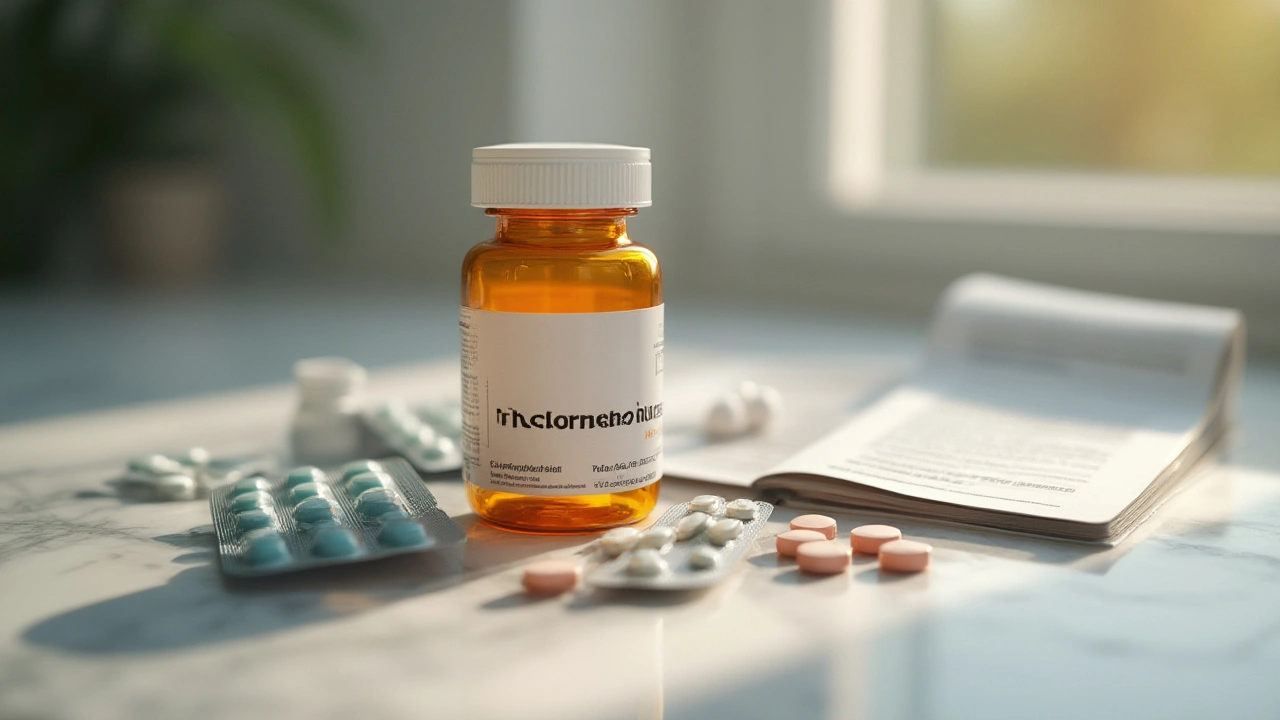If you rummage through an old first-aid kit, you might spot a tiny bottle labeled “chloramphenicol.” It doesn’t look like much, but there’s drama attached to this small antibiotic. It’s saved countless lives and sparked debate among doctors and pharmacists. Chloramphenicol rides that line between being a medical life-saver and a bit of a troublemaker—a rare status in the medicine cabinet. With so much mystery and controversy swirling around it, it’s time to open the cap and really get to know what chloramphenicol is all about.
What Is Chloramphenicol and How Does It Work?
Chloramphenicol is a broad-spectrum antibiotic that first saw the light of day back in 1947, when it was discovered in a soil sample from Venezuela. Talk about humble beginnings. It quickly became famous for fighting nasty bacterial infections, especially when nothing else worked. What sets it apart is that it can cross into places other antibiotics struggle to reach—including the brain, which is why it’s used in life-threatening cases like meningitis.
This antibiotic works by messing with the bacteria’s ability to make proteins. No proteins? No life. Chloramphenicol slips into the cell’s machinery and jams the ribosomes, the essential protein factories. That’s what wipes out the bacteria causing the trouble. Don’t confuse it with antibiotics like penicillin; chloramphenicol has its own unique way of turning off the lights for certain bacteria.
Because of its wide-ranging power, doctors in the past adored it. It’s been used to treat everything from typhoid fever and brain abscesses to eye infections. However, the story isn’t all rosy—sometimes it wipes out good cells too. That’s why it’s now usually reserved for pretty serious situations. It’s on the World Health Organization’s List of Essential Medicines, but with a long list of warnings attached.
Looking at the science, this medicine gets down to business fast. In a decent study from 2018, about 75% of patients with resistant infections improved after just three days of treatment with chloramphenicol. Impressive? Yes. But there are no shortcuts with this drug—overuse can quickly lead to lots of complications.
Main Uses of Chloramphenicol
In today’s doctor’s office, you won’t see chloramphenicol casually handed out for sniffles or sore throats. It’s the serious option when other antibiotics just can’t get the job done. The star uses: bacterial meningitis, severe typhoid fever, rickettsial infections (stuff like scrub typhus), and certain serious eye infections. It’s also still a go-to in low-resource countries, particularly when options are limited by cost or supply.
For eye infections, you’ll often find chloramphenicol as drops or ointment. If you’ve ever gotten a prescription for conjunctivitis (that’s ‘pink eye’ for most of us), the doctor might have sent you home with the familiar small tube. This form is milder, targeted, and less likely to cause the scary side effects that come with tablets or injections.
On the hospital ward, chloramphenicol earns points for being able to cross the blood-brain barrier—that protective layer most drugs can’t pass. That means it reaches the central nervous system, so it’s invaluable for brain infections or when someone is too allergic to use penicillins or cephalosporins. Its ability to work fast and in hard-to-reach spots puts it in a category almost by itself.
But here’s a tip: don’t use this at home without doctor’s orders. The days of self-medicating with leftover pills are over, especially since chloramphenicol comes with a risk of severe side effects.
| Condition | Chloramphenicol Use |
|---|---|
| Bacterial meningitis | Frequently prescribed when alternatives are not suitable |
| Typhoid fever | Option for resistant or severe cases |
| Eye infections (conjunctivitis) | Commonly used in drop/ointment form |
| Rickettsial diseases | Occasionally used as an alternative |

Dangers, Side Effects, and Who Should Be Cautious
Here’s where things get complicated. Chloramphenicol can work wonders, but it comes with some tough warnings. The most infamous side effect is called aplastic anemia—it’s rare, but also pretty scary. Basically, your bone marrow shuts down and stops making new blood cells. That’s not the sort of lottery anyone wants to win. According to data from Public Health England, the overall risk for fatal aplastic anemia is about 1 in 40,000 courses. Sounds low, but imagine if you’re the unlucky one.
There’s also “gray baby syndrome.” Babies, especially newborns, can’t process chloramphenicol fast enough. Their tiny bodies can turn limp and gray because the drug builds up in their system. That’s why doctors avoid giving this medicine to infants, unless absolutely necessary and closely monitored.
Other possible side effects: low white blood cell count (agranulocytosis), allergic reactions, nausea, vomiting, diarrhea, and sometimes mouth sores. Some people get headaches or blurred vision. A few might feel unusually tired. The list’s long, but most folks who are given chloramphenicol in hospital are watched closely, and serious problems are caught early.
Who should be extra careful? Anyone with liver problems, pregnant or breastfeeding women (it passes into breast milk), and—obviously—little babies. If you’ve had bone marrow issues before, tell your doctor before getting anywhere near this drug. Even with topical forms like eye drops, there’s a risk, but it’s tiny compared to taking the tablets or injectable forms.
Chloramphenicol can also mess with other medications. If you’re already on blood thinners or certain seizure meds, your doctor will need to keep a close eye on things. The drug’s good at blocking liver enzymes, which can make other drugs build up to dangerous levels in your system.
How to Use Chloramphenicol Safely: Best Practices and Pro Tips
Rule number one: only take this medicine on a doctor’s orders and stick to the dose prescribed. Don’t be tempted to double up because you missed a pill, and don’t stop early even if you feel better. The danger is bacteria fighting back, building resistance, or you getting hit with rebound symptoms.
With eye drops, make sure your hands are super clean before using them. That alone will head off a host of problems. Never touch the dropper tip to your eyeball or any surface—don’t spread bugs back into the bottle. If you’re using the ointment, just a thin strip inside the lower lid will do the trick.
For anyone taking the tablet form—food can sometimes ease any queasiness. Stay hydrated. Watch for odd bruising or infections, unexplained tiredness, or rash. If anything feels weird, call your doctor right away. The earlier you catch a side effect, the easier it is to sort out safely.
- Keep medicines out of the reach of children.
- Store chloramphenicol drops or ointment in the fridge if that’s written on the label.
- Don’t use eye drops past the expiration date—they lose punch and could get contaminated.
- Finish the whole course, even if symptoms disappear after a day or two.
- See your doctor for regular blood tests if you’re using chloramphenicol longer than a week.
For those allergic to penicillins or sulfas, chloramphenicol can feel like a lifesaver. But swapping antibiotics mid-stream isn’t something you do without the say-so of a doc. Resist the urge to share leftover drops with a friend, too. Infection types and bacteria vary—you could accidentally make things a whole lot worse.

Quick Facts and Frequently Asked Questions About Chloramphenicol
If you still have questions or doubts, you’re not alone. There’s a lot to know about chloramphenicol. Here are some of the most common questions people ask doctors and trusted pharmacists:
- Is chloramphenicol safe in pregnancy? Not unless your doctor says it’s the only safe choice for you—some drugs just aren’t worth the risk.
- Can I use chloramphenicol eye drops if I’m wearing contacts? Pop those lenses out first, use the drops, and don’t put them back in for at least 15 minutes—ideally, wait until your doctor clears you.
- Is it still used much in the UK? For eye infections, yes—you’ll find it in most pharmacies. For other infections, only hospitals use it, and even then, as a backup.
- Are there alternatives? Yes: penicillin, ceftriaxone, amoxicillin, clarithromycin, and many more. But some bacteria laugh at those and only give up to chloramphenicol.
- Can I drink alcohol while using it? It’s better not to. There’s no direct interaction, but both alcohol and antibiotics can add stress to your liver.
- How long does it take to work? Most people notice improvement within a few days, but finish whatever course was prescribed—even if you turn the corner quickly.
- Can my child use it? Only under a doctor’s direction, and the type and dose are strictly controlled. For newborns, doctors usually avoid it.
Doctors and nurses remember chloramphenicol for both the good and the bad. It’s a rare medicine—a hero for tough infections, but not to be toyed with. If it’s prescribed for you or someone you care for, know that the benefits and risks have been weighed carefully. Stick to the directions, keep doctors in the loop, and it can do what few other antibiotics can manage today.

9 Comments
jaya sreeraagam
Okay so I grew up in Kerala where chloramphenicol eye drops were basically the holy grail for pink eye - my mom kept a tube in the fridge next to the pickle jar. We didn’t need a prescription, just a nod from the local pharmacist. I remember my brother got conjunctivitis after swimming and she just slapped those drops in like it was ketchup on rice. No drama, no panic. Fast forward 20 years and now I’m in the States and they treat it like it’s nuclear material. I get it - aplastic anemia is terrifying - but maybe we’ve swung too far the other way? Like, if it’s safe enough for a toddler in rural India, why is it a last-resort here? Just saying.
Also, side note - those drops taste like burnt plastic but they WORK. I’ve used them twice since moving here and saved myself a $200 ER visit. No regrets.
Also also - WHO lists it as essential. That’s not a typo. That’s a global endorsement. We need to stop treating it like a villain and start treating it like a tool - with respect, not fear.
And yes I know I wrote a novel. I’m a long-winded South Indian auntie. You’re welcome.
Katrina Sofiya
Thank you for sharing this thoughtful and clinically relevant perspective. As a registered nurse with over fifteen years of experience in infectious disease units, I can attest to the profound value of chloramphenicol in resource-limited settings and in cases of multidrug-resistant pathogens. Its ability to penetrate the blood-brain barrier remains unmatched by many newer agents, and when used under strict monitoring, it continues to save lives where alternatives are unavailable or ineffective. We must remember that medicine is not one-size-fits-all - what is considered high-risk in a well-resourced hospital may be the only viable option in a remote clinic. Your anecdote resonates deeply with global health realities.
kaushik dutta
Let’s be real - this whole chloramphenicol scare is a product of Western overregulation and pharmaceutical lobbying. In India, we’ve used this for decades. No one’s dropping dead from gray baby syndrome because we don’t hand it out like candy - we use it when it’s needed, and we know the signs. Meanwhile, in the U.S., you’ve got doctors who panic at the word ‘antibiotic’ and prescribe Zithromax for a common cold. Chloramphenicol isn’t dangerous - it’s misunderstood. It’s a potent tool, yes, but so is a chainsaw. You don’t ban chainsaws because someone used one to cut their toe off.
Also, the fact that it’s on the WHO essential list is ignored by American med schools who teach fear over function. This is cultural arrogance disguised as caution. We need to stop infantilizing patients and start trusting clinical judgment. This isn’t a drug to avoid - it’s a drug to master.
doug schlenker
I appreciate both perspectives here - Jaya’s lived experience and Katrina’s clinical insight. I’ve worked in ERs where we had to use chloramphenicol because the patient was allergic to everything else and sepsis was creeping in. It’s not glamorous, but it works. I’ve seen it turn things around. But I’ve also seen the horror stories - the one patient who developed agranulocytosis after a week of treatment. That’s why we don’t use it lightly. Maybe the real answer isn’t ‘ban it’ or ‘use it everywhere’ - but ‘use it wisely, with monitoring, and only when the risk of not using it outweighs the risk of using it.’ That’s medicine, not ideology.
Also, I’ve used the eye drops. They sting like hell but clear up pink eye in two days. I keep a tube in my first-aid kit. No regrets.
Olivia Gracelynn Starsmith
Chloramphenicol eye drops are still the gold standard for bacterial conjunctivitis in many clinics across the U.S. and they’re OTC in some states. The systemic form is the problem not the topical. I’ve prescribed it to hundreds of patients - kids, adults, elderly - and never seen a single case of aplastic anemia. The risk is real but so tiny it’s statistically negligible compared to the benefit. Don’t let fear stop you from using a drug that works. Just follow the instructions. Wash your hands. Don’t touch the tip. Don’t share. Done. It’s not magic. It’s science.
Also - if you’re using it for more than 10 days, get a CBC. That’s it. No drama. No panic. Just care.
Skye Hamilton
So like… I think chloramphenicol is just a villain in a superhero movie. Like, it’s the one drug that’s too powerful to be trusted, right? It’s the Hulk of antibiotics - great when you need it, but if you let it loose without a gamma-ray shield, it’s gonna turn your bone marrow into a ghost town. And honestly? I’m kind of obsessed with how much drama this one little molecule carries. Like, penicillin? Chill. Amoxicillin? Meh. But chloramphenicol? It’s got a whole Netflix documentary in its name. ‘The Silent Killer That Saves Lives.’
Also, I once used someone else’s leftover drops because I was too lazy to go to the pharmacy. I didn’t die. So… maybe the risk is overblown? Or maybe I’m just lucky. Either way - I’m still using them. #ChloroQueen
Maria Romina Aguilar
...I just... I don’t know... I mean, I read the article... and I know it’s important... but I’m just... not sure... I think maybe... we should be more careful... with antibiotics... in general... and... maybe... chloramphenicol... is just... too risky... even if it works... because... what if... something happens... and... it’s... too late...
...I just... I’m worried...
...I’m sorry... I didn’t mean to say anything...
Brandon Trevino
Let’s cut through the sentimentality. Chloramphenicol is not a hero. It’s a blunt instrument. The 1 in 40,000 aplastic anemia rate is a statistical lie - it’s based on passive surveillance in populations with low reporting. Real-world data from the 1970s showed rates as high as 1 in 24,000. And gray baby syndrome? It’s not rare in NICUs where protocols are sloppy. The WHO lists it because it’s cheap - not because it’s safe. The fact that it’s still used in India doesn’t make it right - it makes it tragic. We’ve got better alternatives now: ceftriaxone, meropenem, linezolid. Stop romanticizing a 75-year-old drug because it’s ‘essential.’ Essential doesn’t mean optimal. It means ‘we have nothing better.’ That’s not a badge of honor. It’s a failure of innovation.
Denise Wiley
Okay but can we just talk about how wild it is that a single bottle of liquid from 1947 is still saving lives today? Like - imagine if your phone from 2005 could still take selfies and stream Netflix. That’s chloramphenicol. It’s ancient, it’s gritty, it’s got scars - but it still shows up when it matters. I’ve seen it work when everything else failed. And yeah, it’s scary - but so is childbirth. So is driving. So is life. We don’t ban those. We manage the risk. And honestly? If I had meningitis and this was the only thing that could get me through? I’d beg for it. I’d kiss the bottle. I’d write it a love letter. This drug doesn’t need a PR team. It needs respect. And maybe… a little more love.